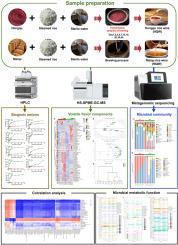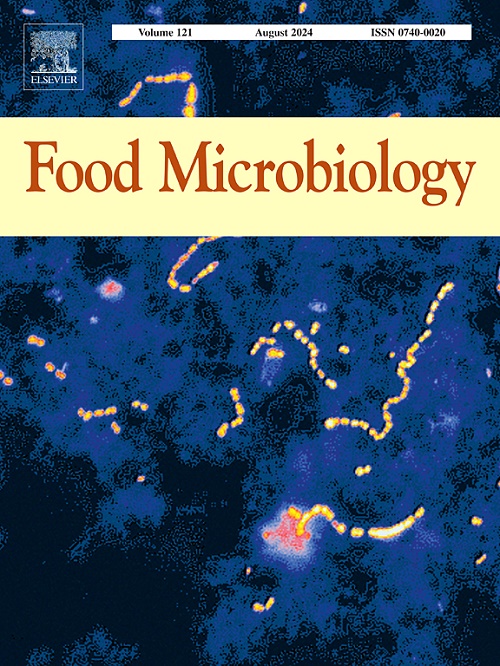Metagenomics reveals the differences in flavor quality of rice wines with Hongqu and Maiqu as the fermentation starters
IF 4.6
1区 农林科学
Q1 BIOTECHNOLOGY & APPLIED MICROBIOLOGY
引用次数: 0
Abstract
Chinese rice wine (CRW) is an alcoholic beverage made mainly from rice or grain through saccharification and fermentation with Jiuqu (starter). Jiuqu makes an important contribution to the formation of the flavor characteristics of rice wine. Hongqu and Maiqu are two kinds of Jiuqu commonly used in CRW brewing. This study compared the microbial community, biogenic amines (BAs), and volatile flavor components (VFCs) of two types of rice wine brewed with Hongqu and Maiqu as fermentation agents. The results showed that the amino acid content of rice wine fermented with Maiqu (MQW) was significantly lower than that of rice wine fermented with Hongqu (HQW). On the contrary, the majority of BAs in MQW were significantly higher than those in HQW, except for putrescine. Multivariate statistical analysis indicated that most of the VFCs detected were enriched in HQW, while ethyl 3-phenylpropanoate and citronellol were enriched in MQW. The results of metagenomic analysis showed that Weissiella, Enterobacter, Leuconostoc, Kosakonia, Saccharomyces, Aspergilus and Monascus were identified as the predominant microbial genera in HQW brewing process, while Saccharopolyspora, Lactococcus, Enterobacter, Leuconostoc, Kosakonia, Pediococcus, Pantoea, Saccharomyces, Aspergillus, Lichtheimia and Nakaseomyces were the predominant microbial genera in MQW brewing. In addition, some VFCs and BAs were strongly correlated with dominant microbial genera in HQW and MQW brewing. Bioinformatics analysis showed that the abundance of genes involved in BAs synthesis in MQW brewing was much higher than that in HQW brewing, while the abundances of genes related to metabolic pathway of characteristic VFCs in HQW brewing were obviously higher than those in MQW, which explained the differences in flavor quality between HQW and MQW from the perspective of microbial genes. Collectively, these findings provide scientific evidence for elucidating the contribution of different microbial genera to the formation of flavor quality of CRW, and is helpful for screening beneficial microbes to enhance flavor quality and drinking comfort of CRW.

元基因组学揭示了以红曲和麦曲为发酵起始物的米酒风味质量的差异
中国米酒(CRW)是一种酒精饮料,主要以大米或谷物为原料,经糖化和九曲发酵而成。九曲对米酒风味特征的形成有重要贡献。红曲和麦曲是华润琼浆酿造中常用的两种酒曲。本研究比较了用红曲和麦曲作为发酵剂酿造的两种米酒的微生物群落、生物胺(BAs)和挥发性风味成分(VFCs)。结果表明,使用麦曲发酵的米酒(MQW)的氨基酸含量明显低于使用红曲发酵的米酒(HQW)。相反,除腐胺外,MQW 中的大多数 BAs 都明显高于 HQW。多元统计分析表明,检测到的大多数 VFCs 在 HQW 中富集,而 3-苯基丙酸乙酯和香茅醇在 MQW 中富集。元基因组分析结果表明,在 HQW 酿造过程中,魏氏菌、肠杆菌、白念珠菌、Kosakonia、酵母菌、曲霉菌和单胞菌是主要的微生物属、而 Saccharopolyspora、Lactococcus、Enterobacter、Leuconostoc、Kosakonia、Pediococcus、Pantoea、Saccharomyces、Aspergillus、Lichtheimia 和 Nakaseomyces 则是 MQW 酿造过程中的主要微生物菌属。此外,一些 VFCs 和 BAs 与 HQW 和 MQW 酿造中的优势微生物属密切相关。生物信息学分析表明,MQW 啤酒中参与合成 BAs 的基因丰度远高于 HQW 啤酒,而 HQW 啤酒中与特征 VFCs 代谢途径相关的基因丰度明显高于 MQW 啤酒,这从微生物基因的角度解释了 HQW 和 MQW 啤酒风味品质的差异。总之,这些研究结果为阐明不同微生物属对华润雪花啤酒风味品质形成的贡献提供了科学依据,有助于筛选有益微生物以提高华润雪花啤酒的风味品质和饮用舒适度。
本文章由计算机程序翻译,如有差异,请以英文原文为准。
求助全文
约1分钟内获得全文
求助全文
来源期刊

Food microbiology
工程技术-生物工程与应用微生物
CiteScore
11.30
自引率
3.80%
发文量
179
审稿时长
44 days
期刊介绍:
Food Microbiology publishes original research articles, short communications, review papers, letters, news items and book reviews dealing with all aspects of the microbiology of foods. The editors aim to publish manuscripts of the highest quality which are both relevant and applicable to the broad field covered by the journal. Studies must be novel, have a clear connection to food microbiology, and be of general interest to the international community of food microbiologists. The editors make every effort to ensure rapid and fair reviews, resulting in timely publication of accepted manuscripts.
 求助内容:
求助内容: 应助结果提醒方式:
应助结果提醒方式:


